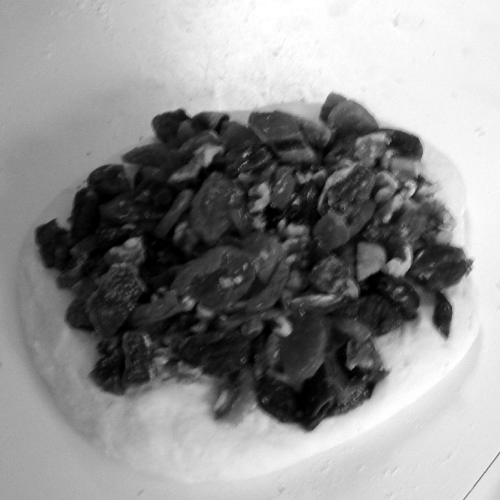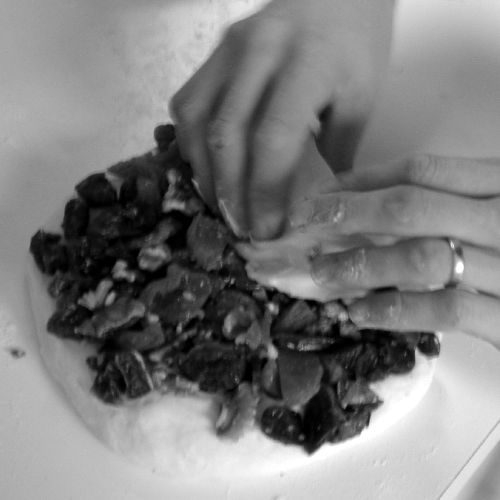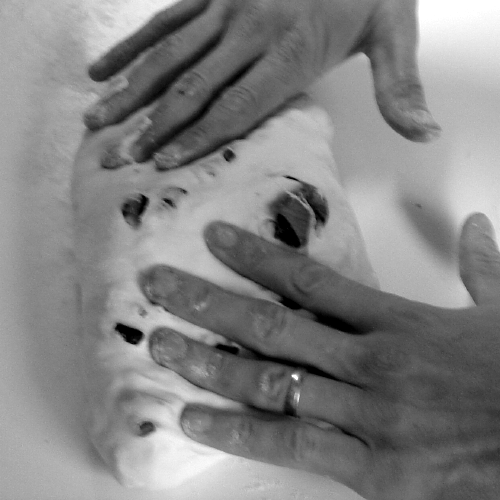On Sourdough Bread Making
Contents
Preface to the Third Revision
(June, 2008)
Apart from transferring these notes to (yet another) wiki, I've streamlined the actual practical bits, and paired back (I know, it is still long-winded!) the 'theory' section. This has come about because I've settled into a longer, but more simplified baking method that approximately follows the Sonoma bakery methodology as learnt there during a tour in 2007. The method seems very reliable and so I pass it on. Not that my previous approaches were fickle, but I think that the previous revisions causes fear by too many 'dos' and 'don'ts'.
The reality is that sourdough bread making is very forgiving -- a point I try to make in the introduction. Indeed, more forgiving than I ever realised. Weights are somewhat important (though my favourite father-in-law begs to differ) and times are even less important (I think we're in agreement on that, now). So on the whole, this revision tries to keep my observations and thoughts, but actually has less on what to do when. It is deliberately short and vague on these points. The reader is encouraged to get in and learn by doing. Sourdough is an interesting and remarkable thing. Enjoy the process of baking, and of course, that first bite on a weekend morning into that Biblically airy, chewy, elastic and flourvourfull loaf!
As ever, Happy baking!
Preface to the Second Revision
This revision has been promised for some time, but through a number of factors is only now being made. Suffice to say, my apologies to those who may have been working from Revision I since, as shall be seen below, my thinking and practice has changed somewhat in the intervening time. I owe a great debt firstly to Richard McIntyre (of Moorooduc Estate, Mornington Penninsula) who kindly gave me a one-on-one sourdough class just prior to Christmas 2005. It was he who introduced me to the 'wet-dough' technique that shall be introduced below. Similarly, to my favourite father-in-law Warren King, whose own experiments in sourdough have informed my understanding greatly. And finally, the Sonoma bakery (Sydney) workshop that Warren and I attended served to cement my knowledge (and is the source of the idea for the excellent spelt fruit-loaf recipe that appears below).
So what demanded this revision? The previous article explained what I shall refer to as a 'dry dough' approach. Not that we were dealing with an unhydrated dough, but in relation to the 'wet-dough' technique that Richard (of Moorooduc Estate) and Andrew (of Sonoma) both practice, the previous recipe employed a less hydrated dough. The wet dough technique has its own problems, but overall, a wetter dough takes care of many of the previous 'faults' that could still occur with the previous method. It is for this reason that I have moved exclusively to this technique.
Furthermore, the article has been reviewed significantly to reflect my own present thinking concerning the emphasis of the bread making problem. Rather than the measures and methodology and timing that was the stuff of the previous revision, this revision will introduce the basic components of the technique and then present a number of different ways to achieve the final loaf. The variety of 'roads' to Rome are due to my own and other's attempts at fitting sourdough into a 'normal' life. Or perhaps I should say, allowing for the 'normal' to survive around the sourdough life.
Of course, as before, I am very keen to hear from experiences 'in the field'. Let me know about problems, questions, and improvements that you have.
Introduction
Different people are driven to this bread for different reasons. For me, memories of chewy, texture-driven, sweetly sour tasting breads of my home town European bakers in Melbourne caused me, after a year or so of modest baking successes with 'inferior' breads, to try my hand at this enigmatic loaf. I recently read the comment from an old french sourdough enthusiast that, 'I only eat sourdough bread, everything else tastes like cake.' Other authors call it 'the zen of bread-making,' or, 'the true bread.' Like all enigmas, the attraction seems to be in the tension between the promise of greatness and the mystique of the unknown. Or, as I reflect on my own experience, learning the art of sourdough has been a fascinating process of occassional triumphant successes amidst a steady normality of spectacular, sometimes humorous, failure.
By way of introduction, I hope this gives some encouragement to those who will attempt this difficult bread and suffer similar frustrations and set-backs. Persevere! Like life, the failures are quickly forgotten when the bread-knife slides through the compressed crumb of a well-made sourdough. I hope that this article offers some kind of short-circuit through the iterative process of flat loaves, sticky-benches, sickly tastes and rock-hard textures. I still have many questions about what is going on in my sourdough methodology -- this is a work in progress -- and therefore feedback is welcomed. But it seemed right to share what I know thusfar, particularly the annotations that I found so lacking in others' depictions of the sourdough story.
The rest of this article is organised as follows. First a review of terminology is given as a reference for novice bakers. Second, a method for forming the starter is given, mostly unchanged from the previous revision. Next, and at the heart of the present method, the components of the wet-dough method are set out, followed by a few different implementations of this basic method. Finally, a discussion of common problems and frequently asked question is given.
NB: A familiarity with general kneeding methods and dough handling is assumed.
Terminology
- Baker's percentage
For a dough, the weight fraction of water in terms of the flour, expressed as a percentage. Hence, a 160g 60 baker's % dough would be one having 60g water and 100g flour. To calculate the amount of flour required for a given weight of dough, divide by 1+b%. Hence, the flour to add to an 800g, 72b% dough would be 800/(1+0.72) = 465g (and 335g water). For what follows, when I use 'b%' I mean for you to read, 'Baker's percent'.
- Wet dough technique
All doughs have water in them, however, normal doughs are usually hydrated between 60-69b% (try calculating b% for some standard 'side of the packet' recipes). The wet dough technique (my arbitrary line) is for doughs hydrated at or above 70b%. For instance, Sonoma baker Andrew uses the wet-dough technique as per the Sonoma region in CA, USA, and uses doughs hydrated between 70 and 75b%. Richard McIntyre uses 74b% for his plain sourdough loaves. See Notes on Kneeding below for how the b% translates to how the dough will handle.
- Starter percentage
- The ratio of starter to other ingredients in the dough. This will vary between 10-40% (normal percent, by weight). For example, a 500g 15% starter dough will have 120g starter, and 380g of flour and water. This ratio affects the time taken in the first prove but little else. As a guide 15% starter dough can stand between 7-10hrs in the first prove, whilst a 40% starter dough only between 3-5hrs. (Before the dough slackens excessively and so will not hold form in the oven (or on the bench!!).)
Making the Starter
On starters
(of course, if you already have a successful starter, skip this section)
What we need for our sourdough, is to catch some natural, and thankfully, air-born bacteria and yeast to act as our leavening agent.* This is different to normal (commercial) yeast bacteria (e.g. 'Lowan' brand, 'dry yeast'). Whereas commercial yeast consumes added sugar (and a little of the flour), operates in low acidity mixtures, and has been selected to leaven bread very quickly (e.g. on the order of 1-2hrs), the natural bacteria/yeast combination we are after actually consumes the flour only (no added sugar required!). A bi-product of this different reaction is lactic acid (amongst other things), which gives the dough its distinctive sour flavour and advantageously preserves the bread for many days against aerobic bacteria that would make it go stale. Many commercial flours are bleached and ground in such a way that natural bacterias are killed. For this reason, when making our initial starter, it is wise to use some organic (unbleached) flour (although not mandatory, I have gained a fine starter from plain 'Savings' brand flour).
Once cultivated, the bacteria-rich starter (as it is known), can be used to leaven our full loaf (obviously we'll need to add some more flour for it to eat). Initially, we'll have a lot of starter, and therefore use only a little of this original mixture. However, as this is depleted, we'll have to regenerate our starter. We don't need to go through the process described below, rather, use a smaller amount of the starter to leaven a loaf, and when your starter is sufficiently depleted, add some more flour and water as described below.
Starter will keep in the bottom of a fridge for many weeks (months actually, though most books will not advise this .. see note below on 'waking' a very old starter). It will need the occassional 'feed' of flour and water, but this is all. Starter is best stored at thick semi-liquid consistency (100b% is perfect) so that air-bubbles that evolve are able to escape the mixture. The alternative is a slowly growing time-bomb.
Starter can also be transported (even overseas if need be) by drying the starter out completely. This is achieved by letting the starter naturally 'dry' out on the bench, but better would be to add more flour until a very hard dough is formed.
* Actually, I read a recent study of where the starter bacteria and yeast originate from. Apparently, the most likely source is the baker .. !
Side note: waking a very old starter
It is possible, though not generally advisable, to wake up a starter that has been neglected for a few months in the bottom of the fridge. On first inspection, it will likely smell something like a paint tin and look little better than drain water. A black-grey liquid will have formed on the top and a very runny, soupy white flour mixture will have formed a lower fraction.
What to do?
- Give the mixture a stir -- it will yield very easily to regaining its mixture. Throw away all but a teaspoon of the sickly stuff. Add your teaspoon to a fresh small bowl and add 100g water and 100g fresh (organic, unbleached if possible) flour. Sit on the bench top with a plastic film covering the bowl.
Come back after 24 hours. Hopefully it should be showing some signs of life. These could be surface mumps indicating that some CO2 is being evolved, or perhaps a stir will give a slightly stretchy, airy texture. Or perhaps not... Throw away most of it, leaving a table-spoon this time, and add 100g water, and 100g flour.
- Come back after another 24 hours. Any improvement? Do this process a couple more times if needs be. Once it has attained a good aerated texture, and is not at all on the nose (i.e. no longer smells like paint stripper) then you are safe.
- Add 200g water and 200g flour to a final 50g take of the active starter and you are in business.
Making a starter from scratch
Ingredients
- 200g organic flour
- 300g tap water
Method
- Add flour and water to a small mixing bowl, mix to rid of lumps, to form a thick but smoothly flowing mixture. (It should be the consistency of thick pancake mixture. Add more water if in doubt.)
- Leave, uncovered for 1 day, then cover with a piece of glad-wrap, putting a small hole in the middle of the wrap with a fork or skewer.
- Leave on a bench for 3-4 days, adding a little more flour (plain) and water each day. The mixture will start to smell, eventually having a pungent yeasty oder. Grey-blue bacterial growths may appear on the surface. The whole mixture will have a grey pall. A clear liquid may form on top. Always mix it all together, with added flour and water to return mixture to original consistency.
- By the end of 4 days, the mixture will be full of leavening agent and thus have a strong odour. Store in the base of a fridge as described above.
To use the starter on a regular basis, as will be seen below, it will be very useful to know the approximate percentage composition of the stater (in terms of flour and water). To do this, take a small amount (a table-spoon will suffice) of the 'rich' starter together with 100g of flour and 100g of water and allow to stand at room temperature for a day. This will give you a rich stater base with a known flour/water content for further use (100b%).
When making up starter amounts therafter, follow the simple rule of 1:1 water:flour. This is the assumed ratio for the recipes given below.
The Sourdough Loaf
Although a longer process than making ordinary bread with dry yeast, the reputation that sourdough bread making is arduous or excessively time-consuming is unwarranted. It is true that from pulling the starter out of the fridge to eating the loaf can take on the order of 24-30hrs (under some approaches), the actual time the baker spends actively working on the loaf would not exceed 30min to 1hour in total. The work is short and very spread, usually before and after a sleep! A little planning means that the sourdough loaf can fit into even the tightest schedule.
Nevertheless, some things can't be faked, and the final sourdough loaf will carry the history of its making in the flavour, texture and crumb and therefore, some lead-processes are squarely undesirable (e.g. shortened proving).
In my experience, the most important variable is the overall length of the bread proving time. Some authors will recommend several hours, others full days, depending highly on the initial leaven to dough ratio. How will the loaf change? The main effect of longer or shorter overall prove times is the sourness -- the acidic content. This is simple to explain -- as the population of organisms spends longer in the water-flour rich environment, it will be exponentially increasing in number, and hence, in outputs of both CO2 and other bi-products like acids. The upside of longer proves is that the dough will first be more sour, and hence tasty, and second, the dough will 'respond' after a 'knock-down' (pushing most of the CO2 out) faster the longer the dough has been fermenting. The downside is that you will get progressively more sour dough until it is sickly sour, and as a consequence, the little yeast/bacteria mixture will have eaten so much of the flour that it will no longer be 'springy', and will instead become very slack and inelastic. This is not cool. A balance must be achieved.
Fortunately, unlike commercial yeasts where the difference between a good loaf and bad is a matter of an hour or so, sourdough is very forgiving -- since we're dealing with overall prove times of about 24 hours, an hour here or there that you miss due to staying out too long, or getting home from work late won't matter at all. Ironically, even though the process is long, this flexibility makes sourdough an easy process to fit in to life.
Side note: Ovens
A final word on ovens. As they say about oils -- 'ovens 'ain't ovens...' Experience is the best ally in this regard. However, some short-comings are treatable.
Recommended for all but the newest electronic style ovens, is to invest (~$7) in an oven thermometer -- then, you will know.
- Second, whether with a fan or not, many ovens suffer from over-shoot or generally poor thermal control dynamics (especially if opening and closing the door to spray the loaf). To this end, cook on a pizza-stone (~$15), pre-warmed with the oven, or -- as I have done thusfar with success -- place your largest, flat-based piece of crockery (e.g. lasagne dish) upside down on a low shelf and put your loaf directly on to this. Be sure to place either aid in the oven while it warms, this will provide both a steady heat-reservoir to control temperature cycles, and a much needed lower source of heat to rise the bottom portions of the loaf in the absence of good fan-forcing. Note, this will slow the warming of the oven. The oven is best if it is piping hot -- with a gas overn 15-20min pre-warming is usually fine, but with an electric at least 30min is required in my experience.
- Finally, it is worth investing further (~$3) in a water spray-bottle to maintain a moist atmosphere in the early stages of cooking. Some bread faults can arise if the oven atmosphere is too dry, though the main point is to keep the dough crust moist. This adds to the suppleness of the crust when the dough is expanding and also provides some moisture for the very good tasting surface reactions (Maillard reactions) of the sourdough loaf to occur. (That which gives the intense brown/black look to even plain sourdough loaves.)
Basic Components of the Wet Dough Loaf
Before laying out all the measurements, I'm going to first introduce the steps involved in making a loaf. The method below is an amalgam of different influences that I've had over time made up principally of: Richard McIntyre (Moorooduc Estate vineyard, Mornington Penninsula), Sonoma bakery (Sydney) and The Bread Builders (book).
The basic components of a 'wet-dough' sourdough loaf are as follows (note: not a recipe! see below for that):
- A quantity of starter (15-40% by weight of final dough);
- Flour and Water to make dough to 70-75b%;
- Salt (about 5g per 750g dough, to taste).
(We shall assume you have prepared a starter as above and have this in the fridge, ready to go.)
Building up the starter |
|||
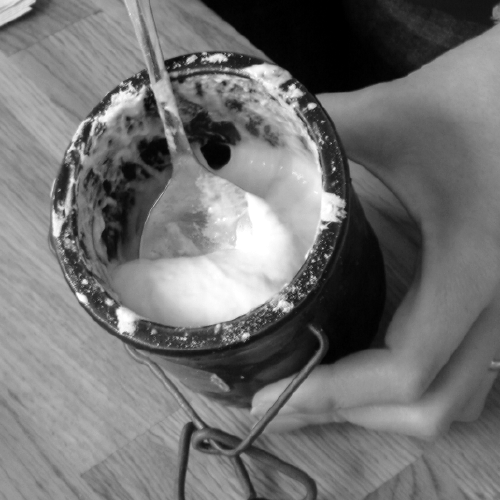 |
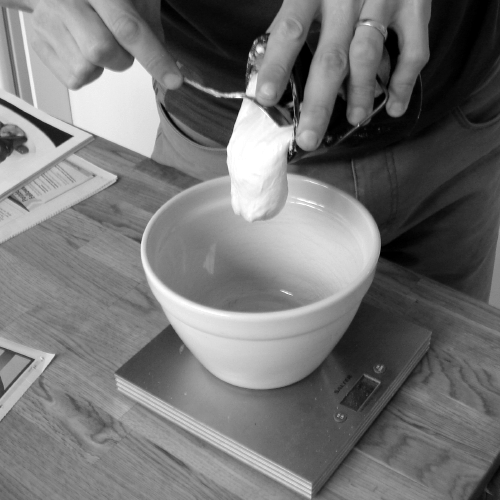 |
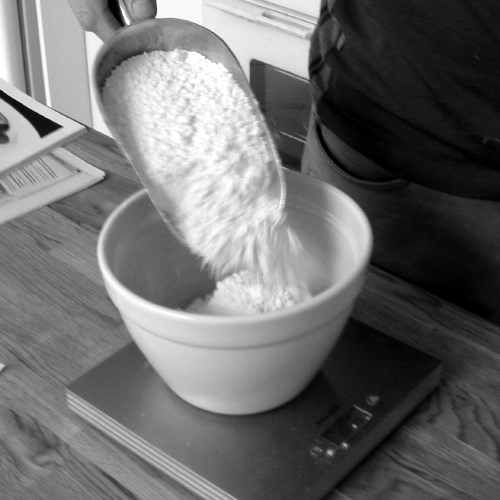 |
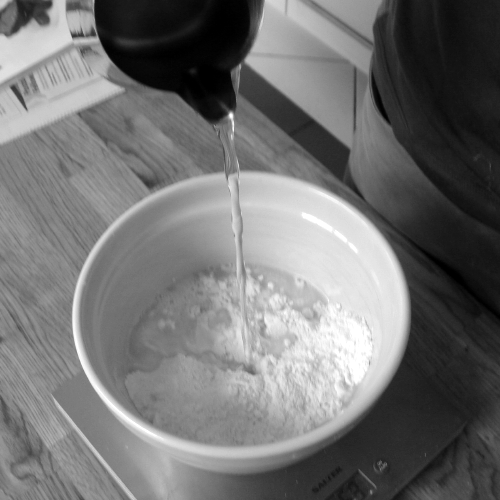 |
The starter pot |
Adding the starter |
Adding flour |
Adding Water |
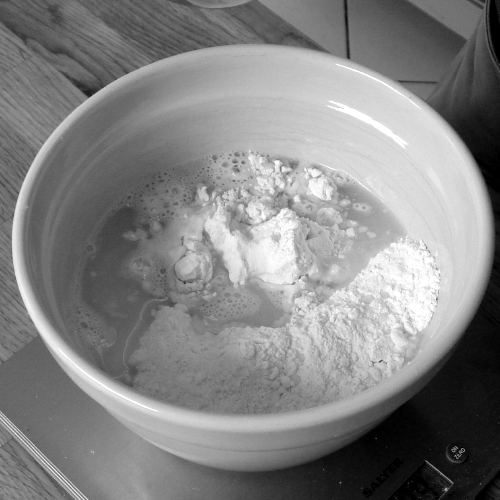 |
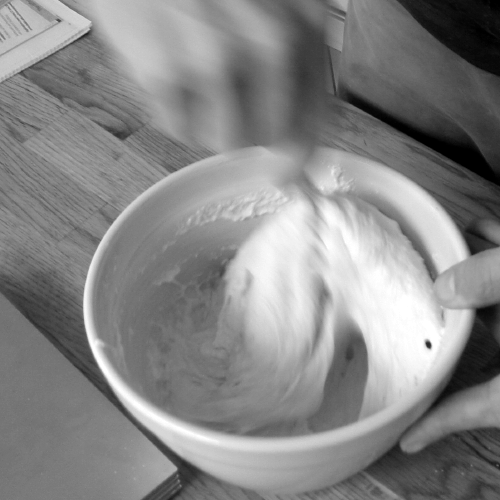 |
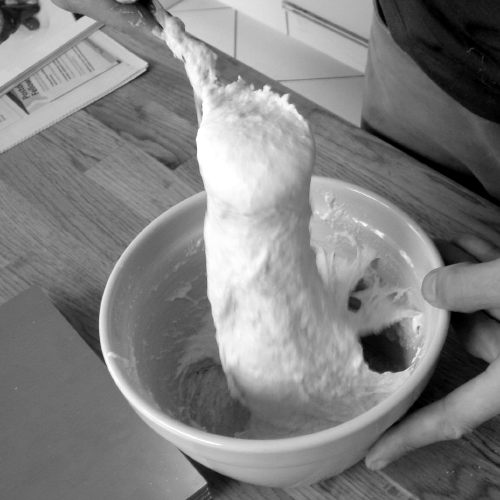 |
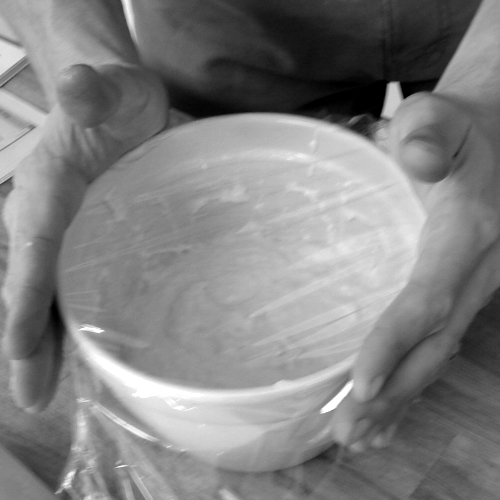 |
Prior to mixing |
Mixing |
The final mix |
Cling wrap it |
- Building up the starter
- Take the starter pot out of the fridge and take a good table-spoon of starter (or more) from your reserve pot and place in a small-medium bowl (NB: take less if it is smelling very potent). Add 1:1 ratio of flour and water, mix well. Leave for 8-12 hours.
Making the dough |
|||
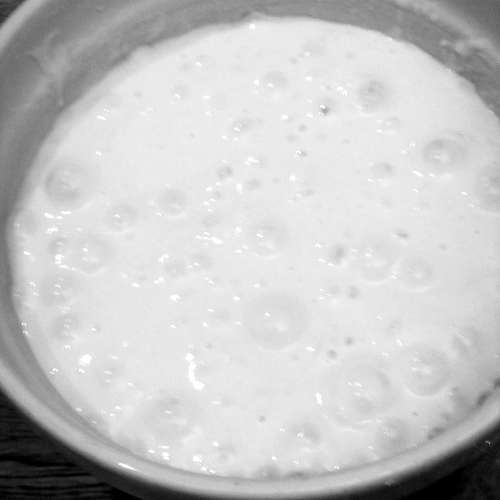 |
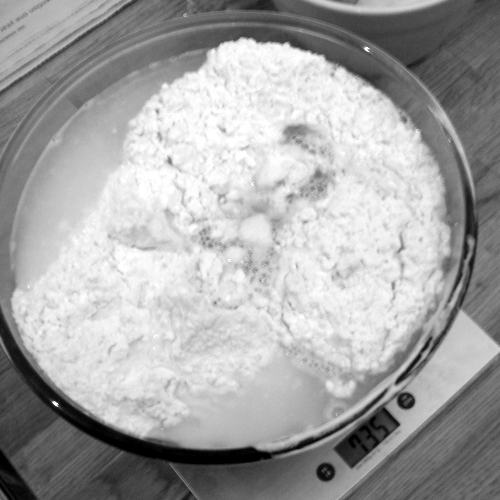 |
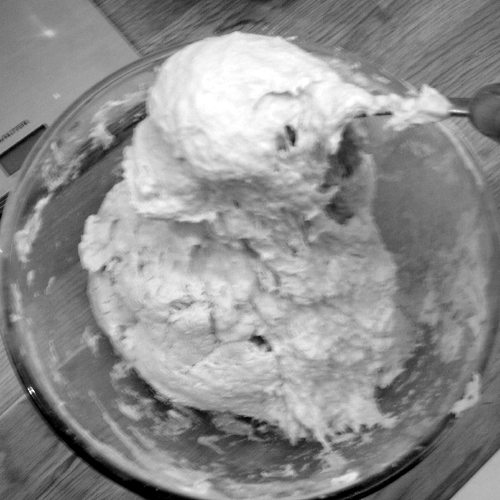 |
 |
The healthy leaven |
Prior to mixing |
First rough mix |
Saving some starter |
 |
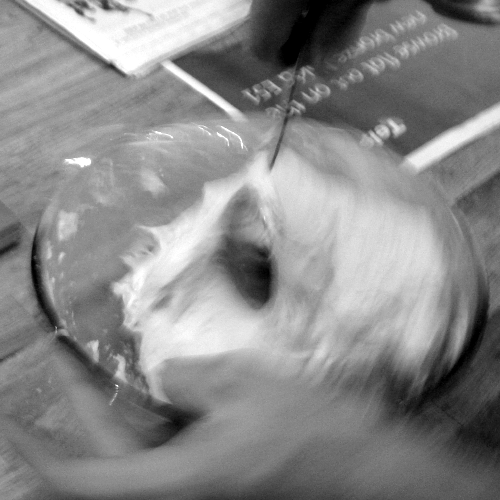 |
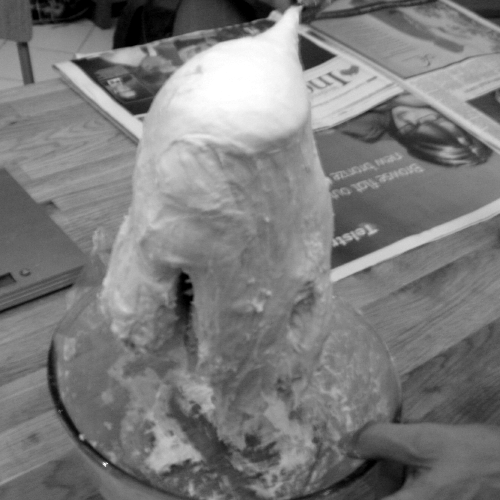 |
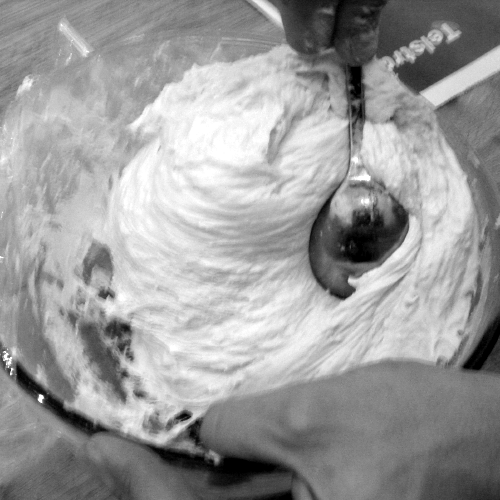 |
Adding the salt |
Second thorough mix |
Stretching the dough |
Forming the dough |
- Making the dough (1)
To the starter mixture add more flour and water as per recipe. Roughly combine to form a soft dough. Don't worry if it doesn't all mix. Rest for 10-30min. We are allowing the flour to expand and relax without the presence of salt. Don't forget to save some starter for next time!! Tip out the old stuff and put the excess new healthy starter into your pot for the fridge.
- Making the dough (2)
Add salt, mix again, now aiming for a smooth dough with all components well mixed. Take out of the bowl onto a slightly dusted bench-top if you like to give a quick need such that the dough is smooth. Miraculously, it should already have formed a reasonable structure (elasticity). Place back in bowl, cover with film and leave for 'a while'.
- First prove
(By the book, Sonoma style) Dough is left in the bowl with plastic-wrap covering for 2-3 hours. Over this time, again, dough will amazingly form a remarkable elasticity. To improve this, take a big spoon every so often and pass it under and through dough, letting whole dough mass fall slowly down either side of the dough in one long stretch. Gather and place back in bowl. (See 'Notes on Kneading' below)
Shaping the loaves |
|||
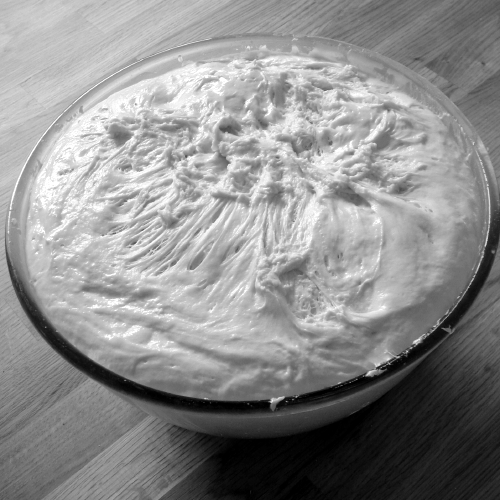 |
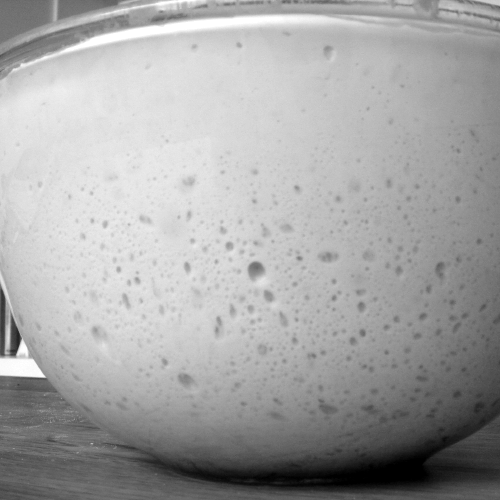 |
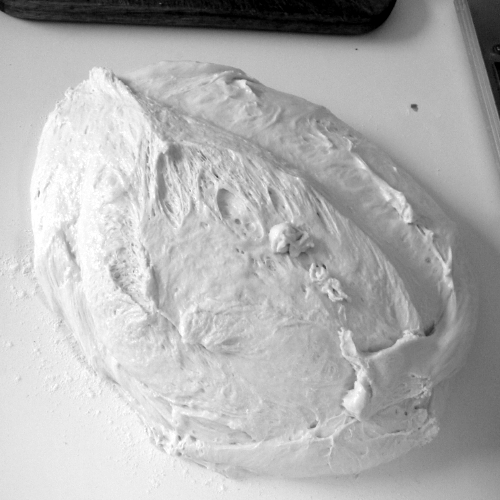 |
 |
After long prove |
Side view |
The full dough |
Cutting into pieces |
 |
 |
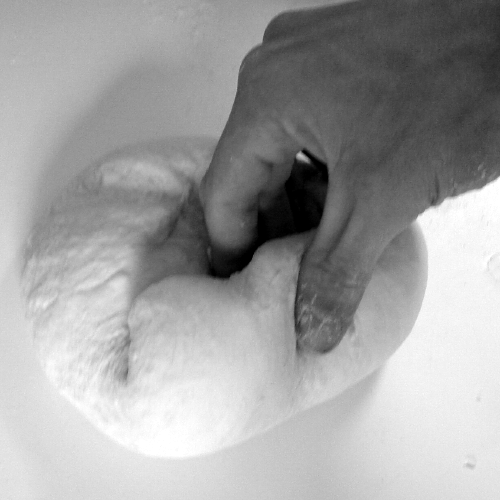 |
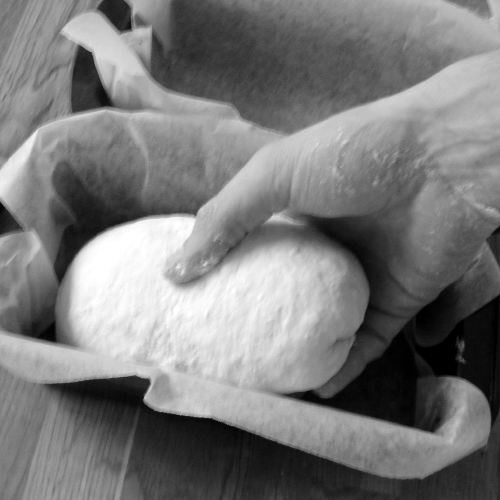 |
Three doughs |
Prepared tins |
Rolling for the tin |
Placing in the tin |
- Shaping
- The dough is turned quickly out onto a lightly dusted bench (a plastic scraper can be helpful for this). Knead lightly to form a managable dough. Have a small pot of flour nearbye to help with kneading, but don't use too much! Now split into loaf weight pieces by cutting with a sharp knife and using scales (e.g. 2 x 750g pieces). Knead each in turn, adding at this stage fruit if needs be. If forming for a tin, add structure and strength by flattening dough out with fingers and hands, and then rolling up tightly to form a thick log, tucking in the ends. Do the same for a 'free-form' loaf, if placing into a floured basket.
- Second prove
- The formed dough is placed in a suitable floured basket, on a bench in a floured tea-towel, or in a bread tin to prove for the second time for approximately 8-10 hrs;
- Prep oven
- About 30min before you wish to cook, warm the oven (with ceramic plate/pizza stone if needed) to approx. 230 degrees C plus, a thorough pre-warm is very important;
- Bake
- The dough should now have approximately doubled in size. If using tins, simply place the tin straight onto the shelf or plate to cook. If making a free-form loaf, turn dough (gently) directly onto the pizza stone or plate. the dough is turned out onto the plate in the oven, a liberal fine water spray is made in the oven cavity (not at the loaf), and slits are made in the top of the dough (all in quick, but safe, succession). Cook for 25-35min depending on oven, loaf should show good oven-spring and form. The loaf is ready when tapping on the base gives a hollow sound.
Notes on Kneading
Kneading the dough has a very special place in bread-making practice. It is assumed that the constant over-lapping and entwining action of kneading brings about that much prized 'springyness' in the final loaf. However, as will be described presently, not all kneading need be so active.
For the less hydrated doughs (up to around 72b%) you will find the dough has a smooth feel from the beginning. To knead this dough takes some care but is very rewarding. The kneading should be done in earnest (not over-doing it) just prior to forming the final dough shape for the second prove. However, with the wetter doughs (over 72b% .. approx.) you will find that the 'dough' is actually quite wet indeed, so much so, that sticking a finger into the mix will cause it to get 'gooped'. Richard McIntyre passed on to me the tip from a busy chef friend of his, who didn't mind this very wet and seemingly unstructured dough, infact, he all but got rid of the traditional kneading stage. The technique for these 'doughs' is that when mixed before the first prove, let the dough rest for 30min, and then with two hands (and a scoop such as a 'Baker's Friend') gather up all the dough and hold it over a bridge made by the outstretched fingers of both hands. The dough will fall very easily at first down either side in two long water-falls. Before the dough snaps, gather it again, and repeat. Do this a couple more times and then plonk back down into the bowl.
Return to the dough about every 20-30min for another two-three times over the first prove and repeat. If like me, you will be amazed to find that the once flowing dough will gradually form into a more 'normal' (but still quite moist) structured dough. The goop comes good. Once a sufficient dough is formed, leave for the rest of the prove. When turning out after the first prove, do some more 'traditional' kneading on a bench top, gathering in a sparing amount of fresh flour. Care must be paid to the way this kind of final dough is proved for the second time -- the tight roll approach is highly recommended, as is supplying the final dough with some side-support during the final prove (e.g. a bowl with steep sides, or on a tea-towel on the bench, between two flat surfaces (e.g. the wall and a large book)).
Notes on retardation
So what if you (like me) make a miscalculation with timings, or something comes up and you can't progress to the next step when you want to. .. Enter the fridge. Commercially, they don't have a 4C fridge, instead they have a 'retard' fridge which can be temperature controlled. Normally it is set to about 7C. The point is that longer doughs are usually better doughs. Good things take time. However, notice that the good thing about the length is that the flour and water get more and more well mixed and elastic. The downside is that if you were to let the dough just sit for a very long time you will allow the sourdough leaven to eat and eat and eat, eventually devouring any texture gains by leaving your dough sickly sour and lacking all structure. This is what the fridge is for. It also helps to standardise the commercial process since even a modern bakery building will likely experience 10-15C temperature changes due to the weather.
Since my fridge is at less than 4C (that's very cold) I like to think of the fridge sort of like a time-machine. For example, if I have got to Saturday morning following A1 (below) and am ready for the oven -- my doughs are nicely risen etc. but then I realise that I'm going on a 3 hour ride (say) .. then my doughs would almost certainly start to slacken if I just let them prove under normal conditions. Instead, I can just whack them into the fridge and when I get back from the ride, I pull them out, with the dough 'stuck' at 7am. Neat. This thinking works pretty well for fridge-stops of up to about 5 hours, but obviously, there is a low level of activity always occuring no matter what the temperature, so you can't 'stop' your leaven indefinitely. But it sure does help.
A Straight Sourdough Loaf
For this section, I present some initial sourdough timetables to get you started. As above, sourdough timing is actually very forgiving. Don't see the below as strict rules to follow, but rather as guides to the land less travelled -- it is up to you to explore and get to know the country. You will innevitably settle on some system that works for your situation.
Ingredients
(This is a (slightly) varied rendition of the Sonoma sourdough recipe)
To make two 750g loaves (1.5kg total dough weight)
- 250g starter*
- 720g organic unbleached flour
- 490mL water
- 10g salt
* starter assumed to be 100b% (i.e. 1:1) hydration
Let's see how the final dough matches up to the Baker's % test (for instruction):
Component |
Flour (g) |
Water (g) |
Component Weight (g) |
Starter |
125 |
125 |
250 |
Added Flour |
720 |
0 |
720 |
Added Water |
0 |
490 |
490 |
Totals (g) |
845 |
615 |
1460 |
So that is 615/845 = 73b%
Loaves for Saturday breakfast or lunch
(Or, The 24hour loaf)
A1. Sonoma-style Loaf, By the Book |
|||
Day |
Time |
Hrs |
Action |
Friday |
~ 9am |
0 |
Reinitiate starter |
~ 6pm |
9 |
Make dough, first prove |
|
~ 9pm |
12 |
(add fruit) Knead, shape, into tins/baskets, second prove |
|
Saturday |
~ 7am |
22 |
Warm oven |
~ 7:30am |
22.5 |
Transfer to oven, bake |
|
~ 8:00am |
23 |
Out of oven, cool |
|
~ 9:00am |
24 |
Eat! |
|
Notice that the above puts the 'short' prove first, the 'long' prove second .. you can make an 'upside down loaf' by reversing these.
A2. Sonoma-style Loaf, Upside Down |
|||
Day |
Time |
Hrs |
Action |
Saturday |
~ 12pm |
0 |
Reinitiate starter |
~ 9pm |
9 |
Make dough, first prove |
|
Sunday |
~ 7am |
19 |
(add fruit) Knead, shape, into tins/baskets, second prove |
~ 10am |
22 |
Warm oven |
|
~ 10:30am |
22.5 |
Transfer to oven, bake |
|
~ 11:00am |
23 |
Out of oven, cool |
|
~ 12:00pm |
24 |
Eat! |
|
To make a fruit loaf
At the shaping stage, combine with a handful (don't hold back) of your choice of favourite dried fruits and nuts such as:
- dried apricots;
- dried figs;
- dates;
- chopped walnuts.
- Hot Tip
Replace the organic flour with spelt flour to make a "Spelt Fruit Loaf". Spelt is more expensive (expect to pay up to $8/kg!) but makes an excellent fruit loaf for breakfast toasting. It is a light flour, with good low-gluten properties for gluten intolerant people (though not low enough for those with Celiacs).
To make a light rye loaf
Replace up to 30% of the added plain flour with rye flour. This will make the dough harder to work (more sticky, usually). You will probably need to keep more dusting flour (plain) on hand, plus some extra water to balance proportions as you knead the loaf. However, a good dough is still obtainable. I prefer this for toast since the rye combines with the sourness to make an excellent, tangy combinatation.
Variations
Other variations abound: * rye and sunflower seed; * honey and oat; * etc.
Some Common Faults & Thoughts on How to Fix Them
- Cracking
- Probably the most common bread fault I've experienced. Again several causes come to mind. My explanation is that, in the oven, the top of the dough has formed a firm crust, but the rest of the dough has got `more to give' and is trying to push up through a firm 'lid'. Consequently, and not surprisingly, it will boost the lid up intact, causing, at times, very unfortunate horizontal cracking right down the length of the loaf, in extreme cases causing slices to have a kind of 'Sigma' shape. (Not so good for breaky presentation.) Cures abound, first make sure the dough is proved away from droughts, perhaps even with a damp tea-towel covering the dough (droughts will prematurely dry out the crust), second, make deeper slashes in the top just before the oven (very effective) -- the thinking here is that the slashed dough will allow deep, 'wet' dough to become exposed, allowing lots of room for growing new surface that is pre-wetted since it comes from the middle of the dough; or finally, an imbalance in the oven temp is to blame -- here focus on that large piece of crockery (or pizza-stone) to distribute the heat (very effective).
- Tunnelling
- Quickly following on from cracking, this is also a cause of great disappointment, the reason being that a loaf will look excellent from the outside, but will sadly, like the Russian Kyoto carbon-credit booty, be full of `hot air'. That is, a long, almost loaf-width, loaf-length hole will be present inside the loaf. Sometimes so bad you can practically hide your fore-arm in there (if you so wished). This has a simple cause -- the dough is not holding together as it pushes up in the oven. The solution: 1) more kneading to develop the structure; or 2) roll that log tighter, making sure that the dough isn't too well floured before rolling up (or else each layer will not stick -- an easy way to get a tunnel).
- Flaky Crumb
What I mean, is that when cut, the loaf looks and feels very similar to so much white-nothingness available in commercially made breads. This is pretty close to the issue here. The dough doesn't have enough sourness to cause it to be `different'. You have essentially made white bread, not sourdough bread. More time proving will almost certainly fix this. (Also, wait till the loaf is completely cool before cutting -- even the best sourdough loaf will have a moist 'crumbly' crumb if cut too early.)
- Sickly Sour
- The opposite of flaky crumb. Caused most often when things bready get forgotten in the chaos of life. The bread has most probably been proved too long. In theory, dead easy to fix, try not to forget the bread!
References and Further Reading
Sourdough at Wikipedia: http://en.wikipedia.org/wiki/Sourdough
Australian Sourdough supplies and Info: http://www.sourdough.com.au
Artisan Baker network Australia/New Zealand: http://artisanbaker.com.au/
Sonoma: http://www.sonoma.com.au/
Moorooduc Estate: http://www.moorooduc-estate.com.au/



